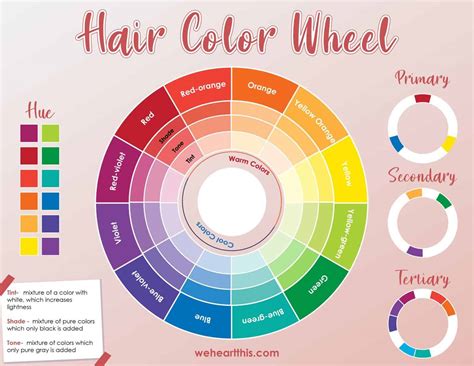Understanding the Hair Color Wheel
The hair color wheel is a visual representation of the relationships between different hair colors. It’s based on the three primary colors (red, yellow, and blue) and their secondary colors (orange, green, and purple).

Colors that are opposite each other on the wheel are considered complementary, meaning they create a contrasting effect when placed next to each other. For example, red and green are complementary colors.
Colors that are adjacent to each other on the wheel are considered analogous, meaning they create a harmonious effect when placed next to each other. For example, red, orange, and yellow are analogous colors.
Hair Color Wheel for Cool and Warm Tones
The hair color wheel can be divided into two main sections: cool tones and warm tones.
- Cool tones: These colors have a bluish undertone and include shades like ash blonde, silver, and icy blue.
- Warm tones: These colors have a reddish undertone and include shades like golden blonde, copper, and mahogany.
How to Use the Hair Color Wheel
The hair color wheel can be used to create a variety of different color combinations.
- To create a contrasting effect: Choose two colors that are opposite each other on the wheel.
- To create a harmonious effect: Choose two colors that are adjacent to each other on the wheel.
- To create a natural effect: Choose two colors that are close to each other on the wheel.
Hair Color Wheel Examples
Here are a few examples of how to use the hair color wheel to create different color combinations:
- Contrasting effect: Red and green, blue and orange, yellow and purple
- Harmonious effect: Red, orange, and yellow, blue, green, and purple
- Natural effect: Blonde and brown, black and brown, red and brown
Color Theory and Hair Color
Color theory is the study of how colors interact with each other. It can be used to create harmonious or contrasting color schemes in a variety of applications, including hair color.
When choosing hair colors, it’s important to consider the following:
- The tone of your skin: Cool tones look best on people with fair skin, while warm tones look best on people with darker skin.
- The color of your eyes: Blue eyes look great with cool tones, while brown eyes look great with warm tones.
- Your personal style: Choose colors that you like and that reflect your personality.
Hair Color Wheel Table
The following table provides a quick reference to the hair color wheel:
| Color | Primary/Secondary | Cool/Warm |
|---|---|---|
| Red | Primary | Warm |
| Yellow | Primary | Warm |
| Blue | Primary | Cool |
| Orange | Secondary | Warm |
| Green | Secondary | Cool |
| Purple | Secondary | Cool |
| Blonde | Natural | Warm |
| Brown | Natural | Warm |
| Black | Natural | Cool |
Hair Color Chart
The following chart provides a visual representation of the hair color wheel:
[Image of hair color wheel]
Hair Color Wheel Quiz
Take the following quiz to test your knowledge of the hair color wheel:
- What color is opposite red on the hair color wheel?
- What color is created by mixing red and yellow?
- What color is created by mixing blue and green?
- What type of color scheme is created by using colors that are adjacent to each other on the wheel?
- What type of color scheme is created by using colors that are opposite each other on the wheel?
Answers to Hair Color Wheel Quiz
- Green
- Orange
- Teal
- Analogous
- Contrasting
Conclusion
The hair color wheel is a valuable tool for anyone who wants to create beautiful hair color combinations. By understanding the relationships between different colors, you can create looks that are both flattering and stylish.
